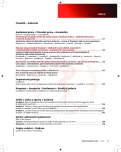Case report: (non)chelated, poly-transfused patient with 5q minus syndrome
Authors:
E. Kadlčková 1; R. Neuwirtová 2; P. Salajka 3; Červínek L.⁴; A. Jonášová 2
Authors‘ workplace:
Hematologicko-transfuzní oddělení Krajské nemocnice T. Bati, Zlín
1; I. interní klinika hematologie Všeobecné fakultní nemocnice Praha, 1. lékařská fakulta Univerzity Karlovy, Praha
2; Patologicko-anatomické oddělení Krajské nemocnice T. Bati, Zlín
⁴Interní hematoonkologická klinika Fakultní nemocnice, Brno-Bohunice
3
Published in:
Transfuze Hematol. dnes,21, 2015, No. 3, p. 136-142.
Category:
Comprehensive Reports, Original Papers, Case Reports
Overview
The authors present a case of a 60-year-old patient with incidentally uncovered significant macrocytic anaemia and thrombocytosis. Myelodysplastic syndrome, namely 5q- syndrome was diagnosed. From the beginning, the patient was dependent on red blood cell transfusions. Chelation was initially successful, but later it failed especially due to the patient’s non compliance. At the time when treatment with lenalidomide was clearly indicated, it was not possible to obtain this medication. At 53 months from diagnosis, the disease progressed to RAEB. The patient died of liver and renal failure without developing acute leukaemia. Severe hemosiderosis of the organs, especially the liver and heart, was one of the causes of death. The article includes the autopsy report and photographs of the relevant histological slides, showing hemosiderosis of the vital organs and pathological-anatomical changes that led to their failure. The paper shows severe organ damage that occurs in patients with untreated iron overload. However, haematologists can currently prevent fatal organ damage in long-term transfused patients suffering from myelodysplastic syndrome with the aid of timely and consistent iron chelator therapy and by attempting to elimi-nate the dependence on transfusions using erythropoietin or in case of its failure by administering lenalidomide.
Key words:
5q-syndrome, iron overload, iron chelation
Sources
1. Žídková M, Voglová J, Bělohlávková P, et al. Novinky v klasifikaci MDS a stanovení prognózy dle WPSS. Transfuze Hematol dnes, 2010;16(1):42–46.
2. Van den Berghe H, Cassiman JJ, David G, et al. Dicstinct haematological disorder with deletion of long arm of no. 5 chromosome. Nature 1974;251:437–438.
3. Neuwirtová R, Jonášová A, Čermák J, a kol. Analýza nemocných s myelodysplastickým syndromem (MDS) s delecí dlouhého ramene 5. choromozomu (del(5q)), sledovaných Českou MDS pracovní skupinou. Význam pro diagnostické zařazení a určení prognózy. Transfuze Hematol dnes, 2009;15:204–209.
4. List A, Dewals G, Bennett J, et al. Lenalidomide in the myelodysplastic syndrome with chromosome 5q deletion. N Eng J Med, 2006;355(14):1456–1465.
5. Komrokji RS, List A. Lenalidomide for treatment of myelodysplastic syndromes. Curr Pharm Des, 2012;18:3198–3203.
6. Rose C, Brechignac S, Vassilief D, et al. Does iron chelation therapy improve survival in regularly transfused lower risk MDS patients? A multicenter study by the GFM (Groupe Francophone des Myelodysplasies). Leuk Res, 2010;34(7):864–870.
7. Čermák J. Přetížení železem – novinky v patogenezi a léčbě. Vnitřní lékařství: 90 let doc. MUDr. Dušana Mrkose, CSc., XXVIII. dny mladých internistů. Sborník abstrakt, 2009;55(Suppl 1):59–63.
8. Pospíšilová D. Současný přístup k léčbě přetížení železem. Farmakoterapie, 2010;6(1):84–90.
9. Wood JC, Enriquez C, Ghugre N, et al. Physiology and pathophy-siology of iron cardiomyopathy in thalassemia. Ann N Y Acad Sci, 2005;1054:386–395.
10. Penka M, Buliková A. Neonkologická hematologie: 2. doplněné a zcela přepracované vydání. 2. vyd. Praha: Grada Publishing, 2009, s. 25–38.
11. Wadei HM, Mai ML, Ahsan N, et al. Hepatorenal syndrome: pathophysiology and management. CJASN, 2006; 1(5):1066–1079.
12. Čermák J, Jonášová A. Doporučené diagnostické a léčebné postupy u nemocných s myelodysplastickým syndromem. Vydala Sekce pro myelodysplastický syndrom České hematologické společnosti ČLS JEP, Praha 2009.
Labels
Haematology Internal medicine Clinical oncologyArticle was published in
Transfusion and Haematology Today

2015 Issue 3
Most read in this issue
- New screening tests for syphilis in blood donors
- Antitumor effects of clinically used iron chelators – review of literature and our own experience
- Acquired uniparental disomy in bone-marrow cells of patients with myelodysplastic syndrome and complex karyotype
- Case report: (non)chelated, poly-transfused patient with 5q minus syndrome
